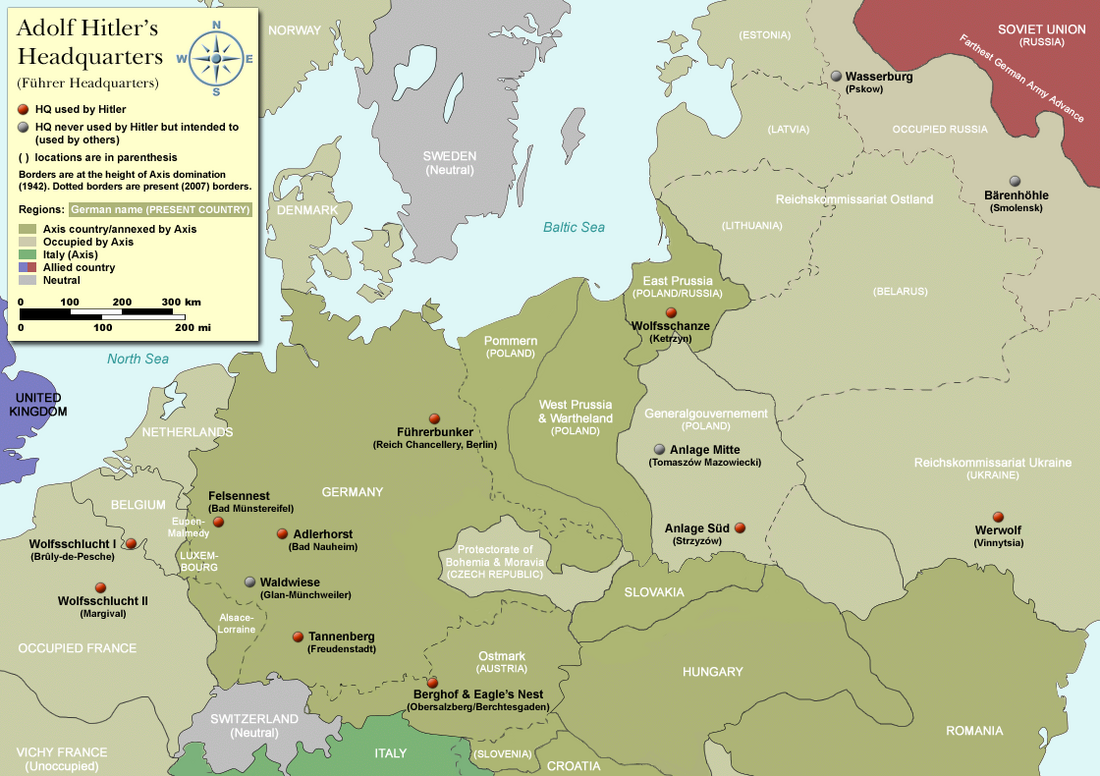Top Qs
Timeline
Chat
Perspective
Führer Headquarters
Administrative centers used by Nazi leaders throughout World War II From Wikipedia, the free encyclopedia
Remove ads
The Führer Headquarters (German: Führerhauptquartiere), abbreviated FHQ, were a number of official headquarters used by the Nazi leader Adolf Hitler and various other German commanders and officials throughout Europe during World War II.[1] The last one to be used, and the most widely known, was the Führerbunker in Berlin, where Hitler committed suicide on 30 April 1945. Other notable headquarters are the Wolfsschanze (Wolf's Lair) in East Prussia, where Claus Graf von Stauffenberg in league with other conspirators attempted to assassinate Hitler on 20 July 1944, and Hitler's private home, the Berghof, at Obersalzberg near Berchtesgaden, where he frequently met with prominent foreign and domestic officials.

Remove ads
Introduction
Summarize
Perspective

At the beginning of World War II there were no permanent headquarters constructed for Hitler. The German leader would visit the frontlines using either aeroplanes or his special train, the Führersonderzug; which could be considered as the first of his field headquarters. The first permanent Führer Headquarters was the Felsennest, used by Hitler during the Battle of France in May 1940. Hitler spent little time in Berlin during the war, and the dwellings he most frequently used were the Berghof and the Wolfsschanze, spending more than 800 days at the latter.
The Führer Headquarters were especially designed to work as command facilities for the Führer, which meant all necessary demands were taken into consideration: communications, conference rooms, safety measures, bunkers, guard facilities, etc. The Berghof and the Obersalzberg complex were modified and extended with considerable defense facilities (bunkers, guard posts etc.). The Wehrmachtbericht, a daily propaganda broadcast covering the war, was transmitted from the Führer Headquarters.
The Fuhrerhauptquartiere programme used over one million cubic metres of concrete, more than half at Anlage Riese and Wolfsschlucht II. Forced labourers worked for nearly 12 million working days—two-thirds at Anlage Riese, Wolfsschlucht II, and Wolfsschanze.[2]
The Führer Headquarters cannot be considered as strict military headquarters; the Wehrmacht had their own, distinctly located in other places, yet often in the vicinity of the FHQs. Nevertheless, because Hitler directly controlled much of the German war effort, the FHQs more often than not became de facto military headquarters. In reality, Nazi Germany's military command during the war generally rested upon Hitler's directives, while the rest of the military command structure, especially the Oberkommando der Wehrmacht (OKW) (directly controlled by Hitler) was reduced to executing his decisions, as compared to most other nations' command structures, which generally had more independence in decision-making.[citation needed]
Terminology

Every place Hitler stayed cannot be considered as a Führer Headquarters, and he did not stay at every official FHQ. Furthermore, some sources may not refer to the Berghof and the Führerbunker as official German Führerhauptquartiere at that time in history, but both of them became de facto Führer Headquarters; thus, they are historically often referred to as such.
The Berghof was modified in much the same way as other FHQs,[3] and Hitler had daily conferences on military matters there in the latter part of the war.[3] The "Eagle's Nest", i.e. the Kehlsteinhaus, was rarely used and may not be considered a FHQ as such alone; however, it was associated with the Berghof and part of the Obersalzberg military complex.
The Führerbunker was located about 8.5 metres (28 ft) beneath the garden of the old Reich Chancellery at Wilhelmstraße 77, and 120 metres (390 ft) north of the new Reich Chancellery building at Voßstraße 6 in Berlin.[4] It became a de facto Führer Headquarters during the Battle of Berlin, and ultimately, the last of his headquarters.[5]

Remove ads
Headquarters locations
Summarize
Perspective
There were about 14 known completed Führer Headquarters (of about 20 planned):[6]
Remove ads
Special train (Führersonderzug)
The Führersonderzug train was named Führersonderzug "Amerika" in 1940, and later Führersonderzug "Brandenburg". The train was used as a headquarters until the Balkans campaign. Afterwards, the train was not used as Führer Headquarters, however Hitler continued to travel on it throughout the war between Berlin, Berchtesgaden, Munich and other headquarters.
See also
- National redoubt (the supposed Nazi "Alpenfestung" (Alpine Fortress))
- Nazi architecture
- Vorbunker
References
External links
Wikiwand - on
Seamless Wikipedia browsing. On steroids.
Remove ads
